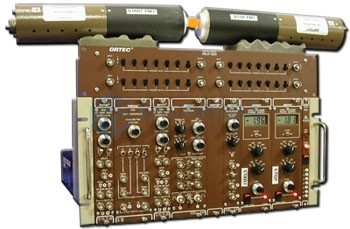Professional Supplier of Laboratory Scientific Instruments
Professional Supplier of Laboratory Scientific Instruments

The existence of positrons was first proposed by Dirac and confirmed experimentally in the 1930s. Positrons are the antiparticles of electrons. A collision of a positron with an electron will cause both particles to annihilate and emit two characteristic 511-keV gamma rays. This phenomenon helps test predictions of quantum theory about the difference between electrons and positrons interacting with matter. Furthermore, positrons have proven to be useful tools for studying various structures and processes. The lifetime of the positron can be used to measure the local electron density at the annihilation point. Annihilation is easily detected with the aid of emitted gamma rays. The positron lifetime technique is one of the few methods that is sensitive to single-atom-scale voids.
• Fully tested and integrated "turnkey" system...all you need is a positron source.
• A complete set of labeled cables and connectors.
• Two Model 905-21 Detector Assemblies.
• Documentation on testing procedures and results.
• 2 Type 905-21 Detector Assemblies.
• 2 Type 583B constant fraction discriminators.
• 2 Model 556 high voltage power supplies.
• 1 Type 414A QuickFit.
• 1 Model 567 Time-to-Amplitude Converter/Single Channel Analyzer.
• 1 Model 928-MCB Multichannel Analyzer with MAESTRO software.
• 1 DB463 delay box.
• 1 Model 4001A/4002D NIM chassis and power supply.
• 1 Type 113 preamplifier.
• 1 Model 575A Spectral Amplifier.
• 1 personal computer.
• 1 set of labeled cables and connectors.
• 1 Procedure and Factory Test Documentation.
The system has a guaranteed time resolution of 200 ps (typically measures less than 180 ps), using a Co-60 source for measurements in a narrow energy window.
(This system does not include sources.)
One of the most important structural issues in soft condensed matter is the presence of unoccupied or free volume between molecules due to irregular packing, density fluctuations, and topological constraints. Free volume is considered to be the fraction of volume capable of molecular recombination and is of great importance in determining the physical and mechanical properties of a system.
PALS is a well-established, unique and versatile technique that allows the direct measurement of these subnanometer-scale molecular free volumes. The PALS experiment injects a positron into the material under test and measures the length of time before it annihilates with one of the material's gamma-ray-producing electrons.

Experienced service team and strong production support team provide client worry-free order service.


If you are interested in any of our products or would like to discuss a customized order, Please feel free to contact us.
Contact Us